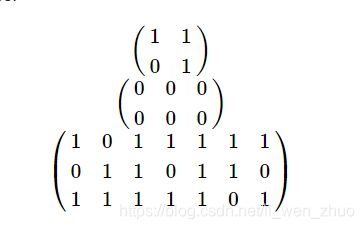- Codeforces Round 972 (Div. 2) A-C 题解
AKDreamer_HeXY
Codeforces比赛题解c++算法动态规划数据结构贪心算法
本来以为B2难度会1900什么的,结果感觉1200还没有,先做的B1,后悔了QwQ关于我现场没切出C这件事……现场排名:A.SimplePalindrome题意构造一个长度为nnn的字符串,只包含aeiou五种字母,需要使得构造出来的字符串所包含的回文子序列数量最小思路当n≤5n\le5n≤5时,只要555个字母不重复出现都是最优情况当n>5n>5n>5时,可以证明:把相同字母放在一起是最优情况:
- Codeforces Round 969 (Div. 2) C. Dora and C++ (裴蜀定理)
致碑前繁花
刷题记录c语言c++开发语言
什么?竟然是裴蜀定理。。。由于这里给出了a和b两个数,我们或许可以想到使用同样是需要给出两个定值的裴蜀定理,即:如果给定xxx和yyy,那么一定有ax+by=gcd(x,y)ax+by=gcd(x,y)ax+by=gcd(x,y)。所以在这时候我们就可以让输入的所有数都去对gcd(a,b)gcd(a,b)gcd(a,b)取模,这样就能够得到所有数的最简形式(可以当成是让所有数尽可能消去aaa和bb
- Codeforces Round #956 (Div. 2) C. Have Your Cake and Eat It Too
abTao_lx
c语言算法开发语言
CodeforcesRound#956(Div.2)C.HaveYourCakeandEatItToo题目大意:有长度为nnn的数组a,b,ca,b,ca,b,c,三个数组的和相同,把nnn分为三段非空连续段[la,ra],[lb,rb],[lc,rc][l_a,r_a],[l_b,r_b],[l_c,r_c][la,ra],[lb,rb],[lc,rc],互不重合。保证∑i=laraai,∑i=
- Codeforces Round #787 (Div. 3)个人题解
旋转卡题
算法贪心算法图论动态规划
CodeforcesRound#787(Div.3)个人题解文章目录CodeforcesRound#787(Div.3)个人题解A.FoodforAnimals题目大意思路参考代码B.MakeItIncreasing题目大意思路参考代码C.DetectiveTask题目大意思路参考代码D.VerticalPaths题目大意思路参考代码E.ReplaceWiththePrevious,Minimiz
- Codeforces Round 966 (Div. 3) ABCDEF
菜比乌斯反演
Codeforces算法c++数据结构
A题:PrimaryTask题意Dmitry写了t个整数,但是在写幂的时候写错了,将^符号给省略掉了。问哪几个是写幂时写错的思路写错的数符合10X,其中X(X>=2)是不含前导零的正整数,我们依此进行判断即可。代码inlinevoidsolve(){strings;cin>>s;intn=s.size();if(n='2'||n>3&&s[2]!='0')cout>n;vectorvis(n+2)
- 程序员进阶之算法练习(四十)Codeforces
落影loyinglin
正文题目1题目链接题目大意:在一维坐标轴上有三个点,坐标是a、b、c;现在需要移动这三个点的位置,使得三个点之间两两间隔大于d;每次只能移动一个点,每秒只能移动距离1;问最少需要多少秒,才能满足要求。输入:一行,四个数字,,,(1≤,,,≤10^9)输出:最少的秒数。Examplesinput5263output2题目解析:a、b、c之间没有关系,可以先排序,使得a=d的时候,ans=max(0,
- Codeforces Round 938 (Div. 3)
沫刃起
codeforces算法c++数据结构
A.YogurtSale#include#defineendl'\n'#defineintlonglongusingnamespacestd;intn,a,b;voidsolve(){cin>>n>>a>>b;if(2*a>t;while(t--){solve();}return0;}B.ProgressiveSquare#include#defineendl'\n'#defineintlongl
- 2023ICPC济南站训练补题
farawaytravelerchy
ACM-ICPC训练补题算法python
title:2023ICPC济南站VP补题记录(第48届)date:2024-01-1812:16:23mathjax:truetags:XCPCcategories:Algorithm文章目录2023ICPC济南站训练补题注:暂时更新vp时ac的4道题,其余题目之后持续更新[Problem-D-LargestDigit](https://codeforces.com/gym/104901/pro
- cf973Div3E
Colinnian
codeforces
https://codeforces.com/contest/2008/problem/Eusingll=longlong;voidsolve(){intn;std::cin>>n;std::strings;std::cin>>s;intans=n;//_____________________________//_____________________________//首先将奇数位置和偶数位
- Codeforces Round 969 (Div. 2 ABCDE题) 视频讲解
阿史大杯茶
Codeforces算法c++数据结构
A.Dora’sSetProblemStatementDorahasasetssscontainingintegers.Inthebeginning,shewillputallintegersin[l,r][l,r][l,r]intothesetsss.Thatis,anintegerxxxisinitiallycontainedinthesetifandonlyifl≤x≤rl\leqx\leq
- CF C. Candy Store
Jiu-yuan
算法
原题链接:Problem-C-Codeforces题意:多测,先给出n代表n种糖果,每种糖果分别给出数量和单价,可以将糖果平均分成若干袋,每一袋的的价格是一袋糖果数量×单价,对于每一种糖果都求出一袋的价格,对于每种糖果都需要用标签贴出一袋的价格,但是如果相邻的糖果价格相同,那么就可以用一个标签来代表价格,问最少使用几个标签。思路:如果一段糖果价格是一样的,那么设置价格为cost。因为每一袋糖果的价
- Codeforces Round 969 (Div. 2):A - Dora‘s Set题解C++,给自己陷入死胡同了,果然真理总是简洁朴素优美
醒了不起的盖茨比Z
c++算法leetcode动态规划c语言图论笔记
先说答案,有需要的大家看看:#includeusingnamespacestd;#defineendl'\n'intmain(){ios::sync_with_stdio(0),cin.tie(0),cout.tie(0);intt,l,r;cin>>t;while(t--){cin>>l>>r;intab=r-l+1;//这一行数字的长度if((ab%4==3)&&r%2!=0)//奇数结尾会有
- 关于求数组中两部分是否相等问题可以考虑前缀和的思路
shadowcase
算法c++
当之后你不记得标题由何而来时,请回顾codeforcesround918(div4)的E题/*这道题的核心就是题干中等式的转化,然后利用前缀和。还要注意flag[0]=1不能漏,不然就都是yes了*/#includeusingnamespacestd;#definelllonglongconstintmaxn=2e5;constintmod=1e6+7;intmain(){ios::sync_wi
- codeforces round 748 题解 A~D2
刘心奶黄包qaq
算法算法c++
文章目录A.Elections题目大意思路AC代码B.MakeitDivisibleby25题目大意思路AC代码C.SaveMoreMice题目大意思路AC代码D1.AllareSame题目大意思路AC代码D2.HalfofSame题目大意思路AC代码A.ElectionsA.Elections题目大意有三个候选人,每个候选人都有一个初始票数,问每个候选人至少增加多少票才能绝对被选上。思路判断其中
- Codeforces Round 963 (Div. 2)
lskkkkkkkkkkkk
题解dp动态规划思维模拟数论
CodeforcesRound963(Div.2)A.QuestionMarks题意有一场考试一共4∗n4*n4∗n道题目,其中答案为A,B,C,D的题目各nnn道,现在你有一份考试的结果,由字母A,B,C,D组成,请问最多得到多少分。思路每种选项最多答对n道题目,我们统计每个选项的出现次数,和n取较小值,将结果加起来即可。代码#includeusingnamespacestd;#defineIO
- Codeforces Round 935 (Div. 3)
lskkkkkkkkkkkk
算法数据结构c++
题目链接A.SettingupCamp题意有一些屋子,每个屋子最多容纳三个人,有三种人,内向人必须一个人一个屋,外向人必须三个人同时一个屋子,综合人随意(一个两个三个都可)现在有aaa个内向人,bbb个外向人,ccc个综合人。问最少需要多少个屋子才能满足所有人的要求,如果无论如何都不能满足那么就输出-1思路我们很容易发现,对于内向人,不会导致输出-1.因为给他们一人一个屋子即可。对于综合人同样不会
- Codeforces Round 936 (Div. 2)
lskkkkkkkkkkkk
c++算法数据结构
CodeforcesRound936(Div.2)题目链接A.MedianofanArray题意给出一个数组aaa,每次操作可以让其中一个数增加一。问最少需要几次操作能改变中位数的值。长度为n的数组a的中位数表示为,令b是a排完序后的数组,那么b⌈n2⌉b_{\lceil\frac{n}{2}\rceil}b⌈2n⌉即为a的中位数。思路假设中位数为mmm,那么我们就需要让最终的中位数变为m+1m+
- CF 967 D. Longest Max Min Subsequence
Jiu-yuan
算法数据结构
原题链接:Problem-D-Codeforces题意:多测,每次给出长度为n的数组,要求找出没有重复元素的,最长的子序列,如果不止一个最长子序列,那么就选择字典序最小的,比较字典序的时候,如果这个元素的下标是奇数,那么就变成负数比较。思路:线段树+贪心,观察题意可知,最终的子序列肯定是正负相间的,那么对于奇数位置,这个数越大越好,对于偶数位置,这个数越小越好。那么就可以贪心的考虑这个问题,设置二
- [Codeforces 115E]Linear Kingdom Races
ddpx3313
c/c++
题目大意:有n块地,初始是荒地。你可以把某些荒地开垦(需要花费相应的价值\(a_i\)(正整数)),然后这些荒地就可以种田。现在有m年,每年要在l到r区间内种田,获得p(正整数)的价值(必须保证l~r都已经开荒,否则不能种田)。问最大收益。解题思路:DP。设F[i][j]表示前i块地,最后有连续的j块地已开荒的最大收益。则\(F[i+1][0]=max\{F[i][j]\}\)。不开荒,则中间断了
- Codeforces Round 917 (Div. 2)
Lanthanmum
算法
A.考虑有没有负数,偶数(把没有负数考虑进去了)就要改变一个数为0,为min,如果是奇数就不用考虑ー、_ィ│/////へ/ノ<|\\//ヽ_ノ(_/│////7|///>―r ̄ ̄`ー―_#include#include#include#include#include#include#include#include#include#include#include#include#include#de
- 【codeforces 115E】Linear Kingdom Races 题意&题解&代码(c++)
deritt
oi之路DERIT的博客专栏线段树-dp
**E.LinearKingdomRaces**timelimitpertest5secondsmemorylimitpertest256megabytesYouareacarraceorganizerandwouldliketoarrangesomeracesinLinearKingdom.LinearKingdomhasnconsecutiveroadsspanningfromlefttori
- E. Linear Kingdom Races
Lanthanmum
算法数据结构动态规划
https://codeforces.com/problemset/problem/115/E线段树优化dpO(n2)->O(nlogn)分析题意发现可以有暴力dpdp(i)是前i条路最大利润dp(i)=dp(i-1)不选第i条路dp(i)=max(dp(j)+val(j)-cost(j))选这i条路dp(i)=max(dp(i-1),max(dp(j)+val(j)-cost(j))显然右边值可
- 2024ccpc中国郑州
Pown_ShanYu
算法
题目链接:Dashboard-2024NationalInvitationalofCCPC(Zhengzhou),2024CCPCHenanProvincialCollegiateProgrammingContest-Codeforces文章目录F.优秀字符串J.排列与合数B.扫雷1A.OnceInMyLifeM.有效算法H.随机栈//Solve函数结合末尾模板F.优秀字符串题意:优秀字符串:长度
- Codeforces Round 967 (Div. 2) C题Guess The Tree
青衫酒145
算法
题目链接令1是根,我们可以一层一层的递推出去。容易知道询问a,b如果结果是c,那么c就是a,b路径上的中点。我们可以先让根1和其他n-1个点都询问一遍,如果返回值是1,那么这些点就是第二层,深度为2的点。我们发现一个c点会对应两层的深节点,比如一条链1234,如果询问13和14返回都会是2,那么我们就让2和34分别连一条边,表示3和4是可能和2直接连边的。然后因为第二层我们已经推出来有哪些点了,再
- Codeforces Round 938 (Div. 3)A-C,E-H
青衫酒145
c语言算法c++
题目链接A.YogurtSale贪心的选两个物品价格少的,若总个数为奇数再加是单个价格代码:#include#definelllonglongusingnamespacestd;voidsolve(){intn,a,b;cin>>n>>a>>b;intr=0;if(n&1){if(b>t;while(t--){solve();}return0;}B.ProgressiveSquare因为c,d大于
- Codeforces gym102423 - J One of Each(贪心 + 栈)
Happig丶
#
传送门题目大意给出nnn个数,仅包含[1,k][1,k][1,k]中的数,且至少含有kkk个不同的数。找到一个长度为kkk的子序列是kkk的一个排列且字典序最小。解题思路这个题算是比较难想的贪心了,而且要用栈维护。一开始用尺取发现维护不了,贪心的话自己又陷入了如下几个误区:如果从后向前贪心,显然是可以的,但是对于已经选过的数,无法得知前缀中待选的数是否能全部出现,即使bitsetbitsetbit
- CF 966 Div3 F. Color Rows and Columns
Jiu-yuan
算法
原题链接:Problem-F-Codeforces题意:多测,每组测试数据给出n和k,n代表有n个长方形,k代表需要的到k分,每个长方形都有宽和高,每次可以填涂一个格子,如果填满一列或者一行就可以获得一分,问达到k分最少需要填涂多少格子。赛时思路:背包dp+随机化,按照背包dp的思路来想,就是选择了某个长方形,如果填满这个长方形分数也不能到达k,那么就直接填满,如果大于等于k那么就用最小代价来填满
- Codeforces Round 966 (Div. 3) 前四题python题解
CodeNerd影
python开发语言
A.PrimaryTasktimelimitpertest1secondmemorylimitpertest256megabytesDmitrywrotedowntintegersontheboard,andthatisgood.Heissurethathelostanimportantintegernamongthem,andthatisbad.Theintegernnhadtheform10^
- Codeforces Round 933 (Div. 3) (A~E)
叶域
算法竞赛算法codeforcesc++
CodeforcesRound933(Div.3)(A~E)目录:ABCDEA题:RudolfandtheTicket标签:暴力枚举(bruteforce)数学(math)排序算法(sortings)双指针算法(twopointers)题目大意给一个长度为n的数组b,和一个长度为m的数组c,还有一个整数k。从b,c中各选一个数,问有多少种选法使这两个数小于等于k思路前缀和快速得出在b数组中小于等于
- Codeforces Round 927 (Div. 3)(A~E)
叶域
算法竞赛c++codeforces算法
CodeforcesRound927(Div.3)(A~E)目录:ABCDEA题:ThornsandCoins标签:动态规划(dp)贪心(greedy)实现问题,编程技巧,模拟(implementation)题目大意由n个连续单元组成的路径,每个单元可以是空的,含有荆棘,或者含有一枚硬币,在一次移动中,你可以沿着路径移动一个或两个单元,前提是目标单元不含有荆棘(并且属于路径)如果你移动到含有硬币的
- scala的option和some
矮蛋蛋
编程scala
原文地址:
http://blog.sina.com.cn/s/blog_68af3f090100qkt8.html
对于学习 Scala 的 Java™ 开发人员来说,对象是一个比较自然、简单的入口点。在 本系列 前几期文章中,我介绍了 Scala 中一些面向对象的编程方法,这些方法实际上与 Java 编程的区别不是很大。我还向您展示了 Scala 如何重新应用传统的面向对象概念,找到其缺点
- NullPointerException
Cb123456
androidBaseAdapter
java.lang.NullPointerException: Attempt to invoke virtual method 'int android.view.View.getImportantForAccessibility()' on a null object reference
出现以上异常.然后就在baidu上
- PHP使用文件和目录
天子之骄
php文件和目录读取和写入php验证文件php锁定文件
PHP使用文件和目录
1.使用include()包含文件
(1):使用include()从一个被包含文档返回一个值
(2):在控制结构中使用include()
include_once()函数需要一个包含文件的路径,此外,第一次调用它的情况和include()一样,如果在脚本执行中再次对同一个文件调用,那么这个文件不会再次包含。
在php.ini文件中设置
- SQL SELECT DISTINCT 语句
何必如此
sql
SELECT DISTINCT 语句用于返回唯一不同的值。
SQL SELECT DISTINCT 语句
在表中,一个列可能会包含多个重复值,有时您也许希望仅仅列出不同(distinct)的值。
DISTINCT 关键词用于返回唯一不同的值。
SQL SELECT DISTINCT 语法
SELECT DISTINCT column_name,column_name
F
- java冒泡排序
3213213333332132
java冒泡排序
package com.algorithm;
/**
* @Description 冒泡
* @author FuJianyong
* 2015-1-22上午09:58:39
*/
public class MaoPao {
public static void main(String[] args) {
int[] mao = {17,50,26,18,9,10
- struts2.18 +json,struts2-json-plugin-2.1.8.1.jar配置及问题!
7454103
DAOspringAjaxjsonqq
struts2.18 出来有段时间了! (貌似是 稳定版)
闲时研究下下! 貌似 sruts2 搭配 json 做 ajax 很吃香!
实践了下下! 不当之处请绕过! 呵呵
网上一大堆 struts2+json 不过大多的json 插件 都是 jsonplugin.34.jar
strut
- struts2 数据标签说明
darkranger
jspbeanstrutsservletScheme
数据标签主要用于提供各种数据访问相关的功能,包括显示一个Action里的属性,以及生成国际化输出等功能
数据标签主要包括:
action :该标签用于在JSP页面中直接调用一个Action,通过指定executeResult参数,还可将该Action的处理结果包含到本页面来。
bean :该标签用于创建一个javabean实例。如果指定了id属性,则可以将创建的javabean实例放入Sta
- 链表.简单的链表节点构建
aijuans
编程技巧
/*编程环境WIN-TC*/ #include "stdio.h" #include "conio.h"
#define NODE(name, key_word, help) \ Node name[1]={{NULL, NULL, NULL, key_word, help}}
typedef struct node { &nbs
- tomcat下jndi的三种配置方式
avords
tomcat
jndi(Java Naming and Directory Interface,Java命名和目录接口)是一组在Java应用中访问命名和目录服务的API。命名服务将名称和对象联系起来,使得我们可以用名称
访问对象。目录服务是一种命名服务,在这种服务里,对象不但有名称,还有属性。
tomcat配置
- 关于敏捷的一些想法
houxinyou
敏捷
从网上看到这样一句话:“敏捷开发的最重要目标就是:满足用户多变的需求,说白了就是最大程度的让客户满意。”
感觉表达的不太清楚。
感觉容易被人误解的地方主要在“用户多变的需求”上。
第一种多变,实际上就是没有从根本上了解了用户的需求。用户的需求实际是稳定的,只是比较多,也比较混乱,用户一般只能了解自己的那一小部分,所以没有用户能清楚的表达出整体需求。而由于各种条件的,用户表达自己那一部分时也有
- 富养还是穷养,决定孩子的一生
bijian1013
教育人生
是什么决定孩子未来物质能否丰盛?为什么说寒门很难出贵子,三代才能出贵族?真的是父母必须有钱,才能大概率保证孩子未来富有吗?-----作者:@李雪爱与自由
事实并非由物质决定,而是由心灵决定。一朋友富有而且修养气质很好,兄弟姐妹也都如此。她的童年时代,物质上大家都很贫乏,但妈妈总是保持生活中的美感,时不时给孩子们带回一些美好小玩意,从来不对孩子传递生活艰辛、金钱来之不易、要懂得珍惜
- oracle 日期时间格式转化
征客丶
oracle
oracle 系统时间有 SYSDATE 与 SYSTIMESTAMP;
SYSDATE:不支持毫秒,取的是系统时间;
SYSTIMESTAMP:支持毫秒,日期,时间是给时区转换的,秒和毫秒是取的系统的。
日期转字符窜:
一、不取毫秒:
TO_CHAR(SYSDATE, 'YYYY-MM-DD HH24:MI:SS')
简要说明,
YYYY 年
MM 月
- 【Scala六】分析Spark源代码总结的Scala语法四
bit1129
scala
1. apply语法
FileShuffleBlockManager中定义的类ShuffleFileGroup,定义:
private class ShuffleFileGroup(val shuffleId: Int, val fileId: Int, val files: Array[File]) {
...
def apply(bucketId
- Erlang中有意思的bug
bookjovi
erlang
代码中常有一些很搞笑的bug,如下面的一行代码被调用两次(Erlang beam)
commit f667e4a47b07b07ed035073b94d699ff5fe0ba9b
Author: Jovi Zhang <
[email protected]>
Date: Fri Dec 2 16:19:22 2011 +0100
erts:
- 移位打印10进制数转16进制-2008-08-18
ljy325
java基础
/**
* Description 移位打印10进制的16进制形式
* Creation Date 15-08-2008 9:00
* @author 卢俊宇
* @version 1.0
*
*/
public class PrintHex {
// 备选字符
static final char di
- 读《研磨设计模式》-代码笔记-组合模式
bylijinnan
java设计模式
声明: 本文只为方便我个人查阅和理解,详细的分析以及源代码请移步 原作者的博客http://chjavach.iteye.com/
import java.util.ArrayList;
import java.util.List;
abstract class Component {
public abstract void printStruct(Str
- 利用cmd命令将.class文件打包成jar
chenyu19891124
cmdjar
cmd命令打jar是如下实现:
在运行里输入cmd,利用cmd命令进入到本地的工作盘符。(如我的是D盘下的文件有此路径 D:\workspace\prpall\WEB-INF\classes)
现在是想把D:\workspace\prpall\WEB-INF\classes路径下所有的文件打包成prpall.jar。然后继续如下操作:
cd D: 回车
cd workspace/prpal
- [原创]JWFD v0.96 工作流系统二次开发包 for Eclipse 简要说明
comsci
eclipse设计模式算法工作swing
JWFD v0.96 工作流系统二次开发包 for Eclipse 简要说明
&nb
- SecureCRT右键粘贴的设置
daizj
secureCRT右键粘贴
一般都习惯鼠标右键自动粘贴的功能,对于SecureCRT6.7.5 ,这个功能也已经是默认配置了。
老版本的SecureCRT其实也有这个功能,只是不是默认设置,很多人不知道罢了。
菜单:
Options->Global Options ...->Terminal
右边有个Mouse的选项块。
Copy on Select
Paste on Right/Middle
- Linux 软链接和硬链接
dongwei_6688
linux
1.Linux链接概念Linux链接分两种,一种被称为硬链接(Hard Link),另一种被称为符号链接(Symbolic Link)。默认情况下,ln命令产生硬链接。
【硬连接】硬连接指通过索引节点来进行连接。在Linux的文件系统中,保存在磁盘分区中的文件不管是什么类型都给它分配一个编号,称为索引节点号(Inode Index)。在Linux中,多个文件名指向同一索引节点是存在的。一般这种连
- DIV底部自适应
dcj3sjt126com
JavaScript
<!DOCTYPE html PUBLIC "-//W3C//DTD XHTML 1.0 Transitional//EN" "http://www.w3.org/TR/xhtml1/DTD/xhtml1-transitional.dtd">
<html xmlns="http://www.w3.org/1999/xhtml&q
- Centos6.5使用yum安装mysql——快速上手必备
dcj3sjt126com
mysql
第1步、yum安装mysql
[root@stonex ~]# yum -y install mysql-server
安装结果:
Installed:
mysql-server.x86_64 0:5.1.73-3.el6_5 &nb
- 如何调试JDK源码
frank1234
jdk
相信各位小伙伴们跟我一样,想通过JDK源码来学习Java,比如collections包,java.util.concurrent包。
可惜的是sun提供的jdk并不能查看运行中的局部变量,需要重新编译一下rt.jar。
下面是编译jdk的具体步骤:
1.把C:\java\jdk1.6.0_26\sr
- Maximal Rectangle
hcx2013
max
Given a 2D binary matrix filled with 0's and 1's, find the largest rectangle containing all ones and return its area.
public class Solution {
public int maximalRectangle(char[][] matrix)
- Spring MVC测试框架详解——服务端测试
jinnianshilongnian
spring mvc test
随着RESTful Web Service的流行,测试对外的Service是否满足期望也变的必要的。从Spring 3.2开始Spring了Spring Web测试框架,如果版本低于3.2,请使用spring-test-mvc项目(合并到spring3.2中了)。
Spring MVC测试框架提供了对服务器端和客户端(基于RestTemplate的客户端)提供了支持。
&nbs
- Linux64位操作系统(CentOS6.6)上如何编译hadoop2.4.0
liyong0802
hadoop
一、准备编译软件
1.在官网下载jdk1.7、maven3.2.1、ant1.9.4,解压设置好环境变量就可以用。
环境变量设置如下:
(1)执行vim /etc/profile
(2)在文件尾部加入:
export JAVA_HOME=/home/spark/jdk1.7
export MAVEN_HOME=/ho
- StatusBar 字体白色
pangyulei
status
[[UIApplication sharedApplication] setStatusBarStyle:UIStatusBarStyleLightContent];
/*you'll also need to set UIViewControllerBasedStatusBarAppearance to NO in the plist file if you use this method
- 如何分析Java虚拟机死锁
sesame
javathreadoracle虚拟机jdbc
英文资料:
Thread Dump and Concurrency Locks
Thread dumps are very useful for diagnosing synchronization related problems such as deadlocks on object monitors. Ctrl-\ on Solaris/Linux or Ctrl-B
- 位运算简介及实用技巧(一):基础篇
tw_wangzhengquan
位运算
http://www.matrix67.com/blog/archives/263
去年年底写的关于位运算的日志是这个Blog里少数大受欢迎的文章之一,很多人都希望我能不断完善那篇文章。后来我看到了不少其它的资料,学习到了更多关于位运算的知识,有了重新整理位运算技巧的想法。从今天起我就开始写这一系列位运算讲解文章,与其说是原来那篇文章的follow-up,不如说是一个r
- jsearch的索引文件结构
yangshangchuan
搜索引擎jsearch全文检索信息检索word分词
jsearch是一个高性能的全文检索工具包,基于倒排索引,基于java8,类似于lucene,但更轻量级。
jsearch的索引文件结构定义如下:
1、一个词的索引由=分割的三部分组成: 第一部分是词 第二部分是这个词在多少

